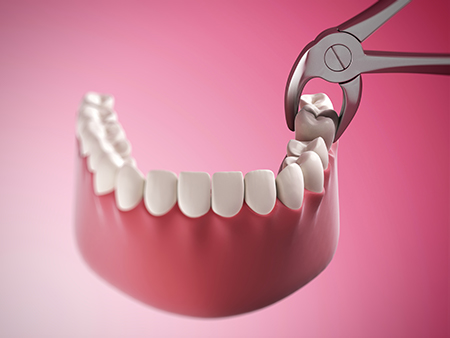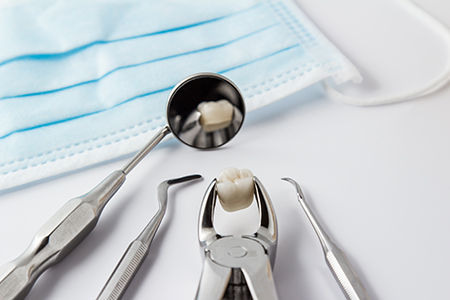Existing Patients
(740) 344-4549
New Patients
(740) 212-1897

At the office of Brian Howe DDS, Family Dentistry, patient comfort and safe outcomes guide every decision we make. Our team approaches extractions with the same attention to detail we bring to preventive and restorative care: careful evaluation, clear communication, and thoughtful planning. When possible we preserve natural teeth, but there are times when removal is the most responsible choice for long-term oral health.
A tooth may need to be extracted to halt the spread of infection, to prevent damage to neighboring teeth, or to remove a source of persistent pain. Extraction can also be a strategic step in treating advanced gum disease, resolving overcrowding ahead of orthodontic treatment, or addressing problematic wisdom teeth. We take the time to explain why removal is recommended and what steps will follow.
Before any procedure, we review medical history, current medications, and any factors that could affect healing. This comprehensive approach allows us to tailor care — from scheduling and anesthesia options to follow-up — so the process is safe, predictable, and as comfortable as possible for each patient.
Persistent primary (baby) teeth that interfere with development
Sometimes a baby tooth does not loosen as the adult tooth tries to emerge. If a primary tooth is obstructing proper eruption or is fused to the jawbone, we may recommend removal to help the permanent tooth come in correctly and to avoid future alignment challenges.
Permanent teeth with extensive decay or structural failure
When decay progresses beyond the point where a crown or filling can reliably restore form and function, extraction can prevent ongoing infection and protect adjacent teeth. Our goal is always to preserve teeth when restorations are a viable long-term solution.
Severe fractures that compromise tooth integrity
Cracks and fractures vary in severity. If a crack extends below the gum line or the root is irreparably damaged, saving the tooth may not be possible. In those situations, extraction can prevent chronic pain and further complications.
Advanced periodontal (gum) disease
Periodontal disease that has reduced the bone and soft-tissue support around a tooth can leave it loose or nonfunctional. Removing teeth that cannot be stabilized helps control disease progression and allows us to focus on restoring a healthy foundation for the remaining dentition.
Impacted or problematic wisdom teeth
Third molars are often the last teeth to develop and may not have enough room to erupt properly. Impacted or misaligned wisdom teeth can cause pain, infections, and harm to adjacent teeth; removing them before they create more serious problems is commonly advised.
Creating room for orthodontic treatment
When the jaws are too small to accommodate all permanent teeth, selective extractions may be part of an orthodontic plan to achieve a stable, functional bite and a balanced smile. These decisions are made collaboratively with the patient and, when appropriate, an orthodontic specialist.

Every extraction begins with a focused clinical exam and clear imaging to understand the tooth’s position, root anatomy, and surrounding bone. We use diagnostic tools — including digital radiographs when indicated — to create a treatment plan that minimizes risk and supports smooth recovery. These images let us anticipate challenges and choose the most appropriate technique.
A full medical history is essential. Please tell our team about prescription medications, over-the-counter drugs, supplements, and any systemic conditions such as heart, bleeding, or autoimmune disorders. In some cases we coordinate with your physician to obtain medical clearance or to adjust medications before the procedure to ensure safety.
We will review anesthesia and sedation options and give clear pre-operative instructions so patients know what to expect on the day of treatment. Our focus is to reduce anxiety, manage pain effectively, and make the experience as calm and controlled as possible for each person in our care.
Simple extractions are performed on teeth that are visible in the mouth and have an uncomplicated root structure. After numbing the area thoroughly with a local anesthetic, the dentist gently loosens the tooth and removes it with forceps. Most patients feel pressure but not pain, and the procedure is typically brief.
We will provide step-by-step instructions before you leave the office and answer questions about pain control, activity, and short-term diet. For those who experience dental anxiety, additional comfort options such as nitrous oxide or oral sedatives may be discussed to make the visit more manageable.
Surgical extractions are used for teeth that are broken at the gum line, impacted, or anchored in a way that requires removal of small amounts of bone or sectioning of the tooth. These procedures may be performed in our office or by a referred oral surgeon depending on complexity and patient needs. Appropriate anesthesia or sedation is provided for comfort.
The surgical technique allows controlled access to the tooth and surrounding structures, and sutures are used when needed to support healing. We will explain the steps involved, anticipated recovery, and any additional precautions in advance so you can plan accordingly.

We respect that many patients feel nervous about extractions. To help, we offer a range of comfort measures tailored to each individual's health profile and anxiety level. Options can include local anesthesia, inhaled sedation (nitrous oxide), or oral sedation under careful supervision. The right choice depends on the procedure, medical considerations, and the patient’s preferences.
Certain medical conditions or medications may require special planning. For example, patients on blood thinners or with immune concerns may need additional precautions or communication with their medical providers. We will discuss any necessary steps well before the appointment so there are no surprises.
Our team emphasizes clear communication and reassurance throughout treatment. You’ll receive written and verbal instructions about how to prepare for the appointment and what to expect during recovery, and we’ll make ourselves available to answer follow-up questions as healing progresses.
Proper aftercare is the most important factor in avoiding complications and speeding recovery. While individual circumstances vary, the basic goals are to control bleeding, limit swelling, prevent infection, and protect the blood clot that forms at the extraction site. We provide specific guidance tailored to the complexity of the extraction.
Early rest and restricted activity help the body focus on healing. Use cold packs to reduce swelling in the first 24 hours and follow our instructions for medications to manage pain and, when appropriate, infection risk. Drink fluids and choose soft foods in the immediate days following the procedure.
If sutures are placed, we’ll tell you whether they are dissolvable or need removal. A follow-up visit may be scheduled for more complex cases to monitor healing and discuss subsequent restorative options if a tooth replacement is desired.
Maintain gentle gauze pressure
Bite on the gauze pad placed over the site to encourage clot formation and control bleeding. Change the gauze as directed and avoid vigorous rinsing or spitting for the first 24 hours.
Protect numb tissues
Until the local anesthetic wears off, avoid chewing or touching the lip, cheek, or tongue near the extraction to prevent accidental injury.
Take medications as directed
Antibiotics:
If prescribed, take the full course exactly as directed to reduce the risk of infection.
Pain management:
Use over-the-counter or prescription pain relievers as recommended. Taking a medication before the numbness completely subsides can help minimize discomfort.
Protect the healing clot
Avoid rinsing, using a straw, or smoking during the initial healing period so the clot is not dislodged. These actions can increase the risk of delayed healing or dry socket.
Control swelling
Apply cold compresses on and off during the first 24 hours to reduce swelling. After that, warm compresses may help comfort and circulation as healing progresses.
Avoid tobacco
Tobacco use interferes with healing and increases complication risk. Refrain from smoking and using other tobacco products while the extraction site heals.
Mind your diet
Stick to soft, nutritious foods and avoid very hot or spicy items during the first few days. Stay hydrated but avoid alcohol and carbonated beverages while you recover.
Keep oral hygiene gentle
Brush carefully around the area and, when advised, use a mild saltwater rinse to keep the mouth clean. Avoid aggressive rinsing or spitting for the initial 24–48 hours.
Attend follow-up care
Return for any scheduled post-operative visits, especially after surgical extractions or when sutures are placed, so we can confirm proper healing and advise on next steps.
If you notice heavy bleeding, increasing pain, fever, or other unexpected symptoms, please contact our office so we can assess the situation and provide guidance.

After an extraction, many patients and clinicians consider options to replace the missing tooth to restore chewing function, esthetics, and long-term oral health. Replacement choices include removable dentures, fixed bridges, and dental implants. Each option has different benefits depending on the location of the tooth, bone health, and the patient's goals.
Dental implants are commonly recommended when a durable, long-term solution is desired and adequate bone support exists. Our team will review the pros and cons of each approach, outline the treatment timeline, and coordinate care if you choose an implant, bridge, or denture. The conversation is individualized — we weigh oral health, longevity, and how the solution fits your lifestyle.
When an extraction is necessary, our priority is to ensure a safe procedure and a clear plan for what comes next. We’ll explain options for replacement as part of your overall treatment plan and help you make an informed decision that supports lasting oral health.
We combine conservative decision-making with practical, evidence-based treatment. Our team is experienced in both simple and complex extractions and collaborates with specialists when advanced surgical care is the safest path. You can expect clear explanations, pre-procedure planning, and consistent follow-up to support a straightforward recovery.
When replacement is appropriate, we will discuss modern options — including dentures, fixed bridges, and dental implants — and help you select a path that meets your functional and cosmetic needs. Our goal is to restore comfort, maintain oral health, and help you return to normal daily activities quickly.
For more information about extractions or to discuss whether removal is the right step for you, please contact our office. We’re happy to answer questions and outline a treatment plan tailored to your circumstances.
At the office of Brian Howe DDS, Family Dentistry a tooth may be removed when it threatens overall oral health due to infection, extensive decay, or a severe fracture that cannot be reliably restored. Extractions are also indicated for teeth that are poorly positioned, such as impacted wisdom teeth, or primary teeth that obstruct normal development of permanent teeth. Removing a tooth can prevent spread of infection and protect neighboring teeth when conservative treatments are not viable.
Periodontal disease that has destroyed supporting bone and soft tissue can leave a tooth nonfunctional and mobile, making extraction the responsible next step to control disease progression. In orthodontic cases, selective removal may be recommended to create space and achieve a stable bite when the jaw cannot accommodate all permanent teeth. We explain the reasons for extraction and discuss alternatives whenever preservation of the tooth is clinically possible.
Decisions about saving or extracting a tooth begin with a focused clinical exam and appropriate imaging to evaluate root anatomy, bone support, and the extent of decay or damage. Digital radiographs and, when necessary, CBCT scans allow us to assess structures beneath the gum line and to anticipate challenges that could affect treatment success. This diagnostic information is combined with a review of the patient’s medical history and symptoms to form a complete picture.
We consider restorative options such as fillings, root canal therapy, or crowns when those approaches offer a reliable long-term outcome. If structural integrity, periodontal support, or infection risk make restoration unlikely to succeed, extraction becomes the more responsible choice. Our team discusses the rationale, expected outcomes, and next steps so patients can make informed decisions about their care.
A simple extraction is performed on a tooth that is visible in the mouth and has an uncomplicated root structure; after local anesthesia the dentist gently loosens and removes the tooth with forceps and most patients feel pressure but little or no pain. These procedures are typically brief and are followed by straightforward aftercare instructions to control bleeding and protect the healing clot. Simple extractions are common for mobile or easily accessible teeth.
Surgical extractions are required when a tooth is broken at the gum line, impacted, or positioned in a way that requires removal of small amounts of bone or sectioning of the tooth to extract it safely. Surgical cases often require sutures and a longer recovery period, and may be performed in the office or by an oral surgeon depending on complexity and patient needs. Appropriate anesthesia and sedation are provided to ensure comfort during the procedure.
Whether a case is simple or surgical, preoperative imaging and a clear treatment plan help minimize risk and support predictable healing. We coordinate referrals to specialists when advanced surgical care or complex pain management strategies are the safest option. Patient-specific factors, such as medical history and anxiety level, influence the chosen approach and anesthesia plan.
Before any extraction we review your medical history, current medications, and any systemic conditions that could affect healing, such as bleeding disorders or immune concerns, and we coordinate with your physician when medical clearance or medication adjustments are necessary. Follow the preoperative instructions we provide, which may include fasting if deeper sedation is planned and avoiding certain medications as directed by your clinician. Clear communication about all supplements and prescriptions helps us manage safety and reduce the risk of complications.
If you expect to receive nitrous oxide or oral sedation, arrange for a responsible adult to drive you home and remain available after the appointment, as recovery from sedation requires supervision. Wear comfortable clothing and make a list of questions or concerns you want to discuss so nothing is overlooked during your visit. Proper preparation reduces anxiety and helps the clinical team deliver efficient, controlled care tailored to your needs.
Local anesthesia is the foundation of pain control for most extractions and numbs the targeted area so patients feel little or no pain during the procedure while remaining awake and responsive. For patients with mild to moderate anxiety we offer inhaled sedation with nitrous oxide, which provides calming effects and wears off quickly after administration. Oral sedation is another option that can produce deeper relaxation and is typically used under careful supervision when indicated.
In select cases where more extensive surgical work is needed or when a patient’s anxiety or medical needs warrant it, we may coordinate advanced sedation or referral to an oral surgeon who provides IV sedation and continuous monitoring. The choice of anesthesia or sedation depends on the complexity of the extraction, the patient’s health profile, and personal comfort preferences. We review risks, benefits, and recovery expectations so you understand the plan and feel comfortable with the approach.
Initial recovery typically focuses on controlling bleeding and swelling during the first 24 to 72 hours, and most patients experience peak discomfort and swelling in that time frame which responds to prescribed or over-the-counter pain control and cold compresses. Rest and limited physical activity help the body begin the healing process, and soft foods are recommended until the surgical site becomes more comfortable. Following aftercare directions closely reduces the chance of complications and supports predictable healing.
Soft tissue usually demonstrates significant improvement within one to two weeks, while underlying bone can take several months to remodel fully after an extraction. If sutures are placed, your clinician will inform you whether they are dissolvable or require removal during a follow-up visit. We schedule follow-up appointments for complex cases or when additional restorative planning is anticipated so healing can be assessed and next steps can be coordinated.
Protecting the blood clot that forms in the extraction site is essential to reduce the risk of a painful condition called dry socket, so avoid actions that can dislodge the clot such as vigorous rinsing, spitting, using a straw, or smoking during the initial healing period. Follow instructions for gentle oral hygiene and use any prescribed antimicrobial rinses or medications as directed to limit bacterial contamination of the site. Keeping activity levels moderate and following dietary recommendations also supports stable clot formation and uneventful healing.
Recognize early warning signs of complications, including increasing pain that is not controlled by medications, a foul taste or odor, or visible bone in the socket, and contact the office promptly if these occur. Timely assessment allows the team to provide interventions that manage pain and promote recovery. Clear communication with your dental provider ensures any concerns are addressed quickly and appropriately.
Contact our office promptly if you experience heavy or uncontrollable bleeding, severe pain that intensifies after initial improvement, fever, or persistent swelling that worsens instead of improving; these symptoms may indicate a complication that requires immediate attention. If you notice signs of infection such as increasing warmth at the site, pus discharge, or a persistent bad taste in your mouth, reach out so we can evaluate and recommend appropriate care. We provide guidance on emergency steps to take while arranging an assessment.
For routine concerns such as prolonged numbness, questions about sutures, or uncertainty about when to resume normal oral hygiene or diet, schedule a follow-up visit so the team can confirm healing progress and offer tailored advice. Keeping scheduled postoperative appointments is especially important after surgical extractions or when additional restorative work is planned. Clear follow-up helps prevent minor issues from becoming more serious.
After a tooth is removed, common replacement options include removable dentures, fixed bridges, and dental implants, each of which has benefits and considerations related to durability, function, and maintenance. Removable dentures can restore basic chewing function and esthetics for multiple missing teeth, while fixed bridges use adjacent teeth for support and can provide a stable, nonremovable solution in suitable cases. Dental implants are a widely used option when a long-term, tooth-root replacement is desired and sufficient bone support exists to secure the implant.
Dental implant treatment typically involves a staged process that includes assessment of bone volume, implant placement, and later attachment of a crown or prosthesis once integration has occurred, and in some cases bone grafting may be recommended to create adequate support. The right choice depends on the tooth’s location, the condition of surrounding teeth and bone, and the patient’s goals for function and appearance. Our team explains the advantages and limitations of each option and helps coordinate care with specialists when complex restorative planning is necessary.
Our practice combines careful diagnosis, conservative decision-making, and evidence-based surgical techniques to ensure extractions are performed safely and with attention to patient comfort and predictable healing. We collaborate with specialists when advanced surgical expertise or sedation is the safest option, and we provide clear preoperative instructions and thorough postoperative guidance to support recovery. Patients can expect a team-oriented approach that prioritizes health, communication, and continuity of care.
Brian Howe DDS, Family Dentistry is located in Newark, Ohio and brings decades of experience to both simple and complex extraction cases, including coordinated planning for tooth replacement when needed. We make time to explain treatment options, address medical considerations, and tailor care to individual needs so patients leave with a clear plan and confidence in their ongoing oral health. If you have questions about extractions or would like to discuss a personalized treatment plan, contact our office to arrange a consultation.
Our friendly and knowledgeable team is always ready to assist you. You can reach us by phone at (740) 344-4549 or by using the convenient contact form below. If you submit the form, a member of our staff will respond within 24–48 hours.
Please do not use this form for emergencies or for appointment-related matters.
